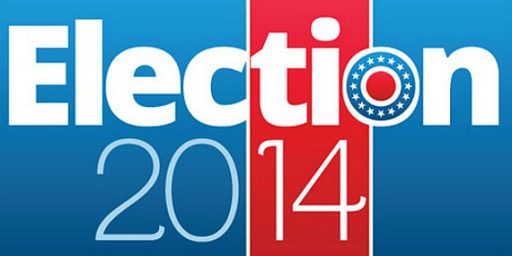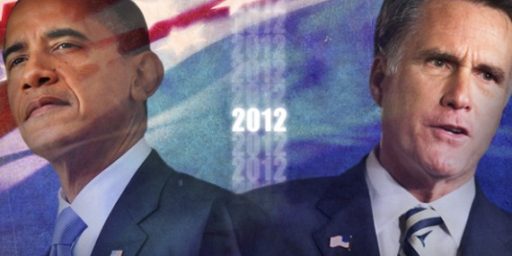Race For Senate Control Tightening
Republicans still have an advantage, but Democrats seem to be holding their own in the battle for Senate control.
For most of the summer, it seemed as though the Republicans were strongly positioned to gain the six seats that they need in order. Some analysts put the odds of the GOP taking the Senate at 60% or higher at various points over the past several months. As is always the case when looking at election races in the summer, though, these analyses were somewhat limited by the fact that large numbers of voters were quite simply not paying attention to the elections very much as well as the fact that many races were not fully resolved until some point in mid-August due to outstanding Republican primaries. Now that we’re two weeks past Labor Day and there are only seven weeks left until Election Day, and especially given the fact that early voting is set to start in many states in the coming weeks, it’s becoming apparently in the polls that voters are paying more attention to the midterms, and its showing up in the polls, and in the analysis of those polls. In the past several days, for example, the analysts at The Upshot, Election Lab, and The Votemaster have all reported that their models show a tightening national race, and Nate Silver says that his analysis shows that the races is very close:
When we officially launched our forecast model two weeks ago, it had Republicans with a 64 percent chance of taking over the Senate after this fall’s elections. Now Republican chances are about 55 percent instead. We’ve never quite settled on the semantics of when to call an election a “tossup.” A sports bettor or poker player would grimace and probably take a 55-45 edge. But this Senate race is pretty darned close.
Most of the Democrats’ gains, however, have come from the purple states. What’s perplexing is that this has happened right as Democrats’ position on the generic congressional ballot — probably the best indicator of the national mood — has deteriorated. Historically, the generic ballot and state-by-state Senate polls — while not perfectly correlated — have moved in tandem more often than not. On average since 1990, a one-percentage-point change in the generic ballot has translated to a half-point change (in the same party’s direction) in the average Senate race.
Might Democrats be benefiting from strong voter outreach in these states — perhaps the residue of President Obama’s “ground game” in 2012? You could make that case in North Carolina, where two polls released on Monday showed a smaller gap between registered and likely voters than most other states that have been polled this year. But this story isn’t so consistent. By contrast, CNN’s poll of New Hampshire on Monday had a conspicuously large turnout gap. And in 2010, presidential swing states showed an especially large turnout drop-off for Democrats.
(…)
Whatever the reason, the GOP’s path to a Senate majority is less robust than before. They still look pretty good in the “path of least resistance” states. But while West Virginia, Montana and South Dakota are extremely likely pickups, Alaska, Arkansas and Louisiana are not sure things. Meanwhile, Republicans have fewer top-tier backup options, as states like North Carolina and Colorado have trended away from them. Republicans may need to decide whether to consolidate their resources. It won’t help them if they lose each of Colorado, Iowa, New Hampshire and North Carolina by a couple of percentage points — and in the process blow a state like Arkansas.
It’s worth noting what Silver is saying here and not to try to turn it into a partisan message for either side. He’s not saying that his model is showing that the GOP will not gain control of the Senate, indeed his model says quite the opposite. What he’s instead saying is that recent developments have made the odds of that happening less likely than they might have been previously, thanks mostly to tightening polls in key races. To that extent, he’s really not saying anything different from Stu Rothenberg and Larry Sabato, who both offered predictions last week of a GOP Senate takeover. These forecasts will obviously change as we get closer to Election Day but, at the moment, the race appears to be tightening nationally, even though there may be some races where one candidate or the other is pulling ahead.
In some states, of course, the race is essentially already over. Beyond the obvious cases of states where one party or the other is guaranteed victory, or in the case of Alabama states where the opposing party didn’t even both to put up a candidate, Republicans will pick up seats in Montana, South Dakota, and West Virginia. Meanwhile, it’s apparent that Democrats will hold on to seats in Michigan, Oregon, and Virginia that the GOP had once hoped would become competitive. In other parts of the country, the story is quite different.
In Kentucky, for example, Mitch McConnell appears to have a solid lead over Alison Lundergan Grimes in a race that many had thought might be winnable for the Democrats due to McConnell’s apparently vulnerability. At least some of that assessment, though, seems to have been based on polling that took place prior to and in the immediate aftermath of McConnell’s bitter primary fight with Matt Bevin. Since then, McConnell has built a steady lead in the polls, including a recent NBC News/Marist poll that put him eight points ahead of Grimes. Additionally, Grimes has not led in a poll since June and has not been within the margin of error since July. While both parties will obviously be dumping a lot of money into this race between now and November 4th, for the moment at least it seems as though McConnell is well suited to hold on to this seat and the GOP will have one less thing to worry about on election night.
On the other side of the aisle, Colorado seems to be race where the Democrats are likely to fend of a challenge in November. Senator Mark Udall’s lead in the RealClearPolitics poll average is not as large as McConnell’s but he has consistently led in every poll conducted since November, while Congressman Cory Gardner has not led in a poll since July and has only had the lead in two polls since March. More importantly, as with Grimes in Kentucky, the recent trends in Colorado are showing Udall rising slightly while Gardner falls in the polls. If that momentum continues, then Udall should be in a good position to hold onto his seat in November, especially given the fact that the presence of a Libertarian candidate in the race, as well as an Independent candidate on the ballot in Colrado’s case, suggests that he can pull off a victory without having to worry about getting above 50% of the vote.
Similar to Udall and McConnell, Senator Kay Hagan continues to perform surprisingly well in her race against North Carolina House Speaker Thom Tills. Presently, she has a 3.7 point lead in the RealClearPolitics Average and her race also includes a Libertarian candidate that has been polling in the high single digits, meaning that Hagan would still pull off a win with less than 50% of the vote as long as she has a plurality. Additionally, the trend lines in North Carolina have so far been in in Hagan’s favor even after at least one debate between the top two candidates. As with Colorado, if that trend continues then Hagan, who had been on the list of most endangered Democrats just a few months ago, is likely headed for re-election.
Beyond these three races, there is good and bad news for both parties. Republican nominee Dan Sullivan seems to have pulled ahead of Senator Mark Begich in Alaska since winning the Republican nomination in mid-August. In another good sign for the GOP, Congressman Tom Cotton is maintaining a consistent lead over Senator Mark Pryor in Arkansas. Over in Iowa, Joni Ernst continues to perform well in the polls, although I must admit I’m skeptical about a Republican who isn’t Charles Grassley winning a Senate race in the Hawkeye State. Republicans are also likely seeing good news in recent polling out of New Hampshire from WMUR and CNN which shows Scott Brown closing the gap with Senator Jeanne Shaheen, although it strikes me that we’d need to see more polling out of the Granite State before calling that race competitive again. On the down side for the GOP, there’s the Senate race in Georgia, where Michelle Nunn remains competitive with David Perdue and, perhaps most ominously, Kansas Senator Pat Roberts finds himself facing a surprisingly strong challenge from an independent candidate that could force the GOP to expend resources in a state that, in a normal year, would be considered safe Republican seat.
Taking all of this together, it seems apparent that we’re looking at a battle for Senate control that is still very much up in the air. There are several factors at play that are favorable for the GOP, such as the nature of the midterm electorate and the President’s approval numbers, which continue to decline even in the wake of an international crisis, of course. This suggests that to the extent likely voters are undecided as we get closer to Election Day, they are more likely to vote for the Republican than the Democrats, which should help candidates like Bill Cassidy in Louisiana, who continues to be in a tight race with Senator Mary Landrieu. At the same time, the fact that candidates like Hagan and Udall seem to be pulling ahead while others such as Pryor and Landrieu remain competitive suggests that it wouldn’t take much to turn what looks like it could be a 51-49 Republican majority after November into a 51-49 Democratic majority.






New PPP poll has Roberts losing to Orman by 7 with Taylor on the ballot, by 10 without.
At the fear of sounding like Superdestroyer, the race so far highlights the trouble the GOP, in its current iteration, in maintaining its status as a national party. It is still likely that it will win 6 seats and the Senate, by taking over the 3 empty seats in deep red states, and ousting incumbents in Louisiana, Alaska, and Arkansas. However, the races in in Colorado, Iowa, and North Carolina are trending away from the GOP, and Michigan and other second-echelon states (with possible exception of New-Hampshire) seem to be out of reach. If the GOP can’t win a single major race in a purple state in a mid-term year in which the President is not popular, they are in serious trouble for the future.
And of course, the KS really complicates the Republican calculus of getting to 51, if the PPP figures Kansasmom posted are anywhere near accurate. If things are as they seem, the GOP needs to sweep KS, AR, AL, and KS to have a bare majority. Since in three of these races republicans are battling incumbents, and they are behind in the fourth, this might be a tall order.
On the subject of Congress, but perhaps a bit OT:
No wonder that Republicans are still stuck in the 50’s.
Republican policies are in the 80s for national security, the 50s socially, and the 20s financially. It’s a strange 30 year gap!
Seems my prediction that the Senate Dems chances will slowly improve is looking better and better. If we see a couple of good economic forecasts the Dems’ chances of holding the Senate will cross 50 per cent. Note that no Republican campaigning anywhere is talking about repealing Obamacare, and Republican governors are one by one embracing Medicaid expansion.
Almost all of these races are tied to the presidents approval rating. its interesting in the new NH Poll that has Brown and Shaheen tied. 54% have a favorable view of Shaheen while Brown’s favorability is not as high. His rating currently sits at 46%. Thirty-eight percent of New Hampshire adults polled approve of the job President Barack Obama is doing, while 60% disapprove.
I think another sharp drop in the presidents approval numbers could spell doom for the Dems and would expect almost all Super Pac (Koch) ads to specifically target Obama.
Somewhat relatedly, while I still give Abbot the lead, losing Houston could spell trouble in his election fight against Wendy Davis. With that in mind, this could end poorly for him:
http://www.dallasnews.com/news/politics/state-politics/20140830-abbotts-houston-raid-didnt-end-with-arrests-but-shut-down-voter-drive.ece
I think this makes it clear that people have a different view of the Republican Party in the abstract than what they see in the actual Republican candidates.
I would guess that the mushy middle remembers the Republican Party of old when asked the generic ballot question, and then recoils a bit when faced with the Tea Party candidates they are being asked to vote for.
Everyone else…each a pretender…is coming back to Sam Wang’s position on this race.
To write this piece, and not include the Princeton Election Consortium…the gold standard of election prediction, approaches malpractice.
Seriously…Real Clear Politics….but no Sam Wang?
Like reviewing food but not mentioning flavors.
@stonetools: Won’t matter which party wins. Both parties are now controlled by powerful, wealthy groups. “Tweedle dee and tweedle dum”
“Fire them all”
@C. Clavin: Sam Wang got his own article, and he is so last month. 🙂
Hagan’s pulling ahead here because plenty of the moderate, traditional Republicans saw the lunacy Tillis and the General Assembly got up to after 2012 when they ousted Bev Perdue. They re-elected Richard Burr in ’12 despite his lockstep voting for obstructionism partly because Elaine Marshall wasn’t that strong a candidate and partly because they hadn’t been exposed to just how radical an uncontrolled Republican majority can get.
Hagan’s also appealing to the moderate far more than expected, and it’s resonating well in a state that’s been red since the ’70s nationally but always voted Democratic in local and state elections.
@Tillman:
I think Doug is browny-ing up for a gig with RCP someday…they lean way to the right also.
Who cares? IF the DEmocrats have 51 seats in the Senate or the Republicans have 51 seats in the Senate, does anyone think that there will be any real difference in policy or governance in the U.S. The only thing that is relevant to policy and governance is when will the Democrats regain control of the House. My guess is that gridlock will continue until 2022 when demographic changes in the U.S will give the Democratic Party a majority that they will not lose again.
What no one is pointing out is as the Democrats pick up more seats in the South, the party will be able to be more liberal while looking less liberal.
Here’s a report that shows why the Republicans are still likely to take the Senate:
Reading the article, it’s pretty plain that a witches’ brew of Republican propoganda, stupidity and-I’ll say it-raw racism is driving southern white voters to vote against their interests. This is the Republicans’ ace in the hole in its drive to take the Senate this year. This is depressing and a lot of conservative posters and commenters will downplay the influence of these factors. But the report makes it clear that southern whites’ hatred of Obama is the ill wind that’s filling the Republicans’ sails. It’s something that statistics just can’t measure-but it’s there.
As I have reminded everyone before, in August of 2012 Nat Silver had the Repubs with a 60% chance of winning control of the Senate. In the end they actually lost 2 seats. The problem is that predictions based on ‘generic ballot’ or ‘pres popularity’ or whatever, are all moonshine. Elections are (almost always) a contest between 2 candidates and the candidates matter. Wait for the head to head polls to come out. For the Senate and House, head to head polls come late in the cycle, if they come in at all (most house races are not polled). Now we are seeing actually polls being rolled into the models, the numbers are changing.
Not that any of these models matter. The only poll that matters is the one on election day. My bet is that even the final models, which are usually pretty good, will be off just like last time. A couple of surprises for the senate on election night would be normal.
@jib:
Every model is contingent on events between now and Election Day.
@jib:
That isn’t correct. While Silver in 2011 considered Republicans the odds-on favorites to win the Senate, by May of the following year he had shifted to projecting that it was a toss-up, with Dems having a slight advantage on the assumption that Angus King would caucus with them:
http://fivethirtyeight.blogs.nytimes.com/2012/05/16/democrats-odds-of-retaining-senate-improve/
He gradually moved up Dems’ prospects as the year progressed, and by election time he called every Senate race correctly except Montana and North Dakota.
@Tillman: Here’s an article about their first debate to demonstrate my point. Tillis is attempting a Mitt Romney and is just failing spectacularly.